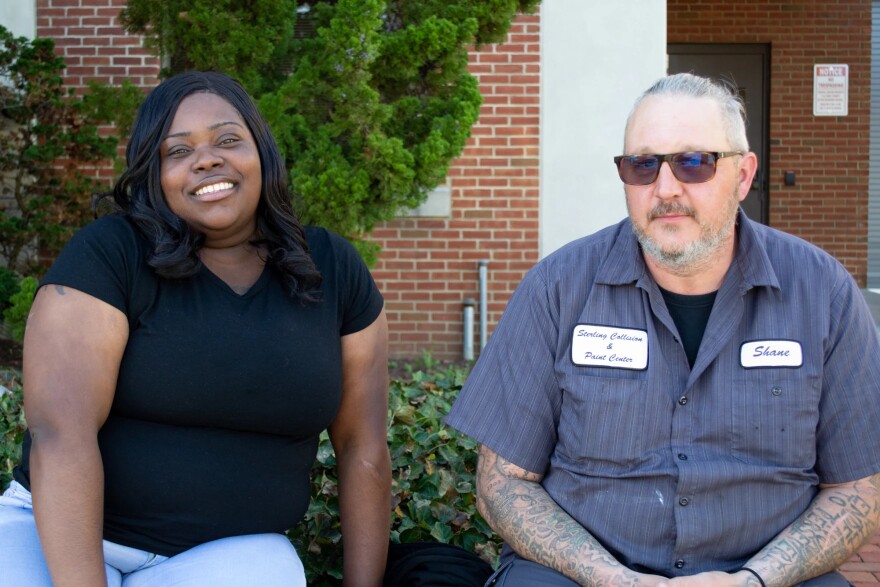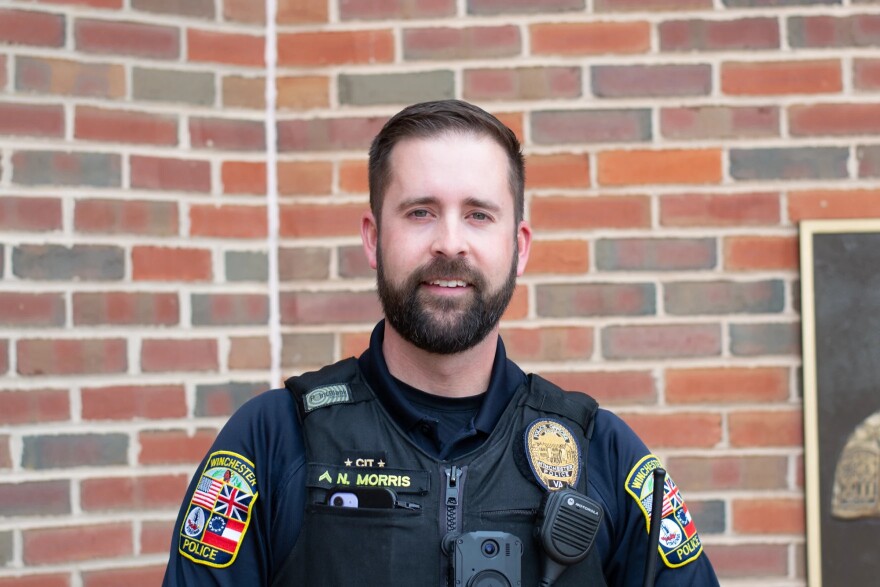Editor's note: This piece, originally a two-parter, has been consolidated and lightly edited for length and clarity.
Read the original Part 1 on WMRA's website.
Read the original Part 2 on WMRA's website.
A little before 2 p.m. on a recent Tuesday, just over a dozen people milled about in the Winchester Circuit Courthouse. An officer opened the courtroom doors, and the group filed in, lining the wooden benches.
When Judge Alexander Iden mispronounced someone's name, everyone laughed — including Iden — because this was not a typical hearing or a trial. This was drug court, a program designed to help people with nonviolent charges and a substance-use disorder get sober and get their lives back together.
Iden asked the participants, one by one, "So — what'd you learn this week?"
They talked about attending Narcotics or Alcoholics Anonymous meetings, organizing a school supplies drive and making it through a brother's funeral. At the end of each interview, the judge announced how long that person had been sober — and the whole room clapped, whether it had been 20 days or 500.
Shane Bowlen, 44, is in the final phase of the program.
“The biggest thing about the program is honesty. It's not just being honest with everybody else, but being honest with yourself, that the change that you want to make is real and sincere,” Bowlen said. “Most people think that you just make a change one day and decide that you don't want to do it anymore, and it's done, but that's not the way it works. It's an everyday thing.
“It's every day of, when you get upset, or a family tragedy happens, or you know, anything in life that's not a standard of what you think should go your way. It's that ultimate thinking pattern that hits that goes, ‘Oh, I just need to go get high.’"
Bowlen praised the clinicians at Northwestern Community Services Board in Winchester, which provides the treatment part of drug court. Outside of the program, he enjoys volunteering with the Timbrook Achievement Center, a local after-school program, and riding motorcycles.
“I've got a 2000 Harley Road King, is one of them, and then I've got a 2018 CVO. And other than that, I mow grass,” Bowlen said. “I ride around my compound with a riding mower with my hand out. But these are all things I've learned to do and enjoy without being under the influence of something. I mean, it's really enjoyable. It's just like the day today. It's just a nice, peaceful day right now, and it's sunny and it's beautiful outside. I can enjoy it — I'm sober.”
Participants are referred to the drug court by commonwealth's attorneys in Winchester as well as Clarke and Frederick counties. It's run by the Northern Shenandoah Valley Substance Abuse Coalition, and the staff are working toward starting drug courts in Warren and Shenandoah counties later this year.

Drug court coordinator Jane Ewing and director Teresa Cluss said people who go through drug court struggle with a variety of substances
“Yeah, opiates, opioids, but it changes,” Cluss said. “So right now, they're seeing some meth, as well.”
“And cocaine is big. It was, really, when we look at all of our participants, kind of the top drug of choice was cocaine,” Ewing said. “Followed with opiates and meth. And usually, it's always a mixture.”
All participants start out in intensive outpatient therapy, which for some includes medication-assisted treatment — such as with suboxone, which is used to help people wean off of opioids.
From there, coordinator Jenna Barsotti explained, “There is a "seeking safety" track, which is … a trauma-based group. They also have "dual diagnosis," so if you have mental health as well as substance use. And then they have "relapse prevention, relapse recovery" … that's just the general track.”
It usually takes 18 to 24 months to complete the program. The drug court has admitted a total of 101 participants so far: 45 have graduated, and 34 have been kicked out. There are 20 people still in the program. And, sadly, two have died — neither from drug overdoses, although Ewing said relapses do happen.
We did just recently, in drug court, have one of our participants overdose on fentanyl,” Ewing said. “It terrified our client. It terrified us. The treatment team came up with a real in-depth [plan] to get him back on course.
Ewing said the court tried to help participants recover from relapses — as long as the person is honest about what happened.
Treatment challenges and solutions
But there are rules, and sanctions for breaking them.
Jasmine Dorsey, 29, told WMRA she started drug court last June. She broke curfew early on and had to serve five-and-a-half months of a four-year suspended sentence. She said the house arrest imposed in these early phases has been challenging.
“You have to text when you're leaving somewhere, when you get there, when you're leaving there and going back home,” Dorsey said. “You have to send a text message every time, and that's hard. The accountability, the responsibility is serious in this program.”
But she said the classes, especially one called Moral Recognition Therapy, have been helpful in dealing with her anger.
If you really want to better yourself, and you really want to stay sober, then I will push for this program. But that's something you really have to be serious about.” Dorsey said. “Luckily for me, I have a great family, so everybody's close and that's really how I spend my days outside of drug court. … I have a pretty good job. I do in-home care, and it fits my schedule perfectly, and still leaves me some time in my day before my curfew and stuff. So, I'm blessed.”
Dorsey said that anyone trying to get clean by going to a 30-day inpatient program needs to have other services lined up afterwards. Ray Goode, the community outreach manager with the BrightView treatment center in Winchester, echoed that sentiment.
“They come back to their home, and their same places, family, and it's really difficult to navigate that addiction without having services available to them,” Goode said. “So I'm trying to work with the places in Arlington, Northern Virginia, Virginia Beach, things like that, to be able to say … ‘Make sure patients have resources available to them as they leave an inpatient program.’ It's so critical to their recovery.”
BrightView is a private provider offering individual and group therapy, case management and medication-assisted treatment. Goode said the organization takes all types of insurance and helps uninsured patients sign up for Medicaid or apply for financial assistance.
The task force currently operates in Winchester and Front Royal, as well as Clarke, Frederick, Page and Shenandoah counties.
According to a report the Northwest Virginia Regional Drug and Gang Task Force recently presented to drug court staff, the task force seized a little over 1,000 grams of fentanyl in 2021. Last year, it was more than double that — most commonly, in the form of blue fentanyl pills that are made to look like 30mg tablets of oxycodone.
Its data counted 250 overdoses in the region in 2021. Twenty-six of those were fatal. In 2022, there were 165 overdoses reported, but 31 were fatal. However, those numbers could underreport the frequency of nonfatal overdoses.

Winchester Police Cpl. Nathan Morris has responded to a lot of overdose calls in his 12 years with the department.
“I don't feel like it's as frequently anymore, with the availability of Narcan,” Morris said. “When I first started, [it] ranged anywhere from two to three a week, and then some nights I feel like you could get two to three a night.”
Narcan is a nasally-administered medication that can reverse the effects of an opioid overdose. Some of those revived by Narcan may not call 911 or go to the hospital, so they won't end up in official counts.
Earlier this year, Morris assumed the newly-created position of addiction resource officer. Next month, he'll shadow the addiction response team in Hamilton County, Ohio — which includes Cincinnati — to see how their program operates.
For people considering seeking treatment for substance use, drug court participant Shane Bowlen has a word of encouragement.
“I've been an addict for 30 years. Before I came to this program, I was an active addict of two and a half years, every day. Crystal meth was my drug, and you know, for those people that are out there that are stuck and feel like there's nobody there, there are people there that really do care,” Bowlen said. “The help is out there if you want it. And there's a better life, there really is.”


